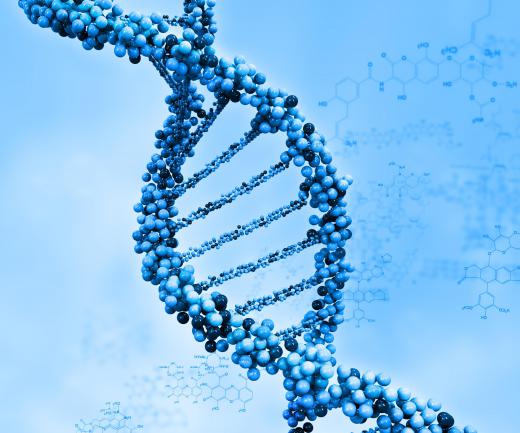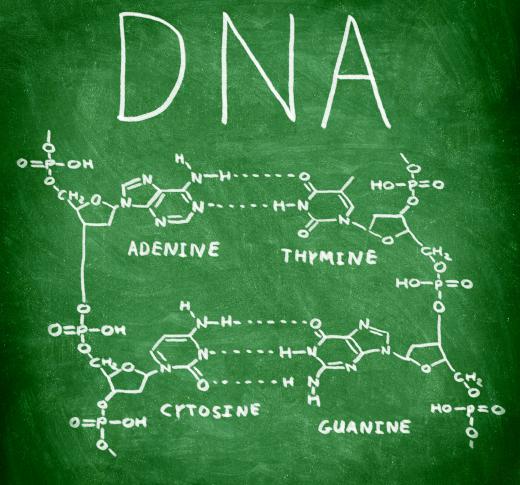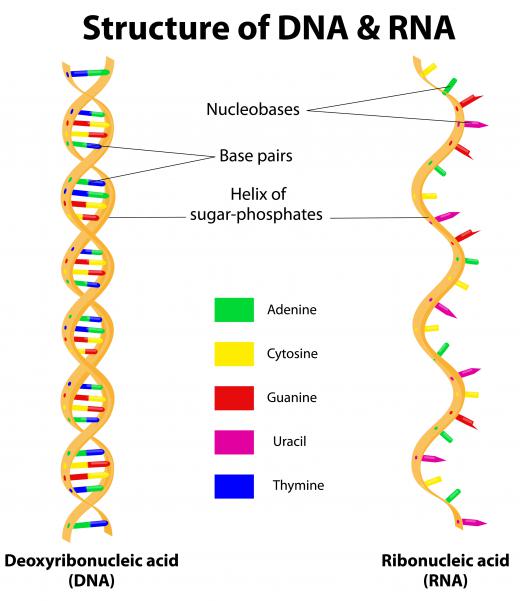What are Base Pairs?
 Mary McMahon
Mary McMahon
Base pairs are pairs of nucleotides joined with a hydrogen bond found in DNA and RNA. This genetic material is typically double-stranded, with a structure which resembles a ladder, and each set of base pairs making up a single rung of the ladder. Base pairs have a number of interesting properties which make them topics of interest, and understanding how base pairs work is important to many geneticists.
The nucleotides which make up DNA are adenine (A), thymine (T), cytosine (C), and guanine (G). In RNA, the thymine is replaced with uracil (U). Together, these small chemical compounds make up the genetic code of an organism, with their arrangement coding for the production of a number of proteins. Adenine can only bond with thymine, and cystosine can only bond with guanine. This means, for example, that when a strand of DNA is examined, if there's a A on one end of a rung, a T must be on the other.

Adenine and guanine are both types of molecules known as purines, while thymine and cytosine are pyrimidines. Purines are larger, with a structure which prohibits two of them from fitting on one rung of the ladder, while pyrimidines are too small. This means that adenine cannot become a base pair with guanine, and thymine cannot be in a base pair with cytosine.

One might reasonably ask why the purine adenine couldn't bond with the pyrimidine cytosine, and why thymine cannot bond with guanine. The answer has to do with the molecular structure of these compounds; adenine cannot form a hydrogen bond with cytosine, just as thymine cannot form a hydrogen bond with guanine. These properties dictate the fundamental arrangement of base pairs, with the compound on one end of the rung dictating which compound will lie on the other side.

It takes numerous sets of base pairs to make up a single gene, and any given strand of DNA can contain numerous genes in addition to sections of what is known as “non-coding DNA,” DNA which does not appear to have any function. The human genome contains an estimated three billion base pairs, which explains why it took so long to successfully sequence the human genome, and understanding the arrangement of base pairs doesn't help people understand where specific genes lie, and what those genes do. In a way, base pairs could be considered the alphabet which is used to write the book of the genetic code.
AS FEATURED ON:
AS FEATURED ON:













Discussion Comments
So how does base pairing work in DNA?
What are the number of base pairs and the sequence of gene IGF2 for homo sapiens?
This non-coding DNA (formerly "junk DNA") still has base pairs though, true? It doesn't code for proteins but it's part of the instructions to turn DNA off or on to control whether or not the gene is expressed.
Studies are showing that variations in the DNA interval (how long the base pair strand is) on a certain chromosome increases risk of coronary artery disease.
Post your comments